DOE Introduces Roadmap To Accelerate Connection Of More Clean Energy Projects To The U.S. Electric Grid
The U.S. Department of Energy (DOE) has released a roadmap named, The Transmission Interconnection Roadmap, indicating solutions to proceed with the interconnection of clean energy onto the nation’s transmission grid and clear the existing backlog of solar, wind, and battery projects.
The roadmap, developed by DOE’s Interconnection Innovation e-Xchange (i2X), will serve as a guide for transmission providers, interconnection customers, state agencies, federal regulators, transmission owners, load serving entities (LSEs), equipment manufacturers, consumer advocates, equity and energy justice communities, advocacy groups, consultants, and the research community, including DOE.
It sets success targets for interconnection improvement by 2030 and outlines tools to improve the process for connecting more clean energy projects to a reliable grid and help achieve the Biden-Harris Administration’s goal of 100% clean electricity by 2035.
“Clearing the backlog of nearly 12,000 solar, wind, and storage projects waiting to connect to the grid is essential to deploying clean electricity to more Americans,” said U.S. Secretary of Energy Jennifer M. Granholm. “Through the i2X program, the Biden-Harris Administration is accelerating the interconnection process by ensuring all stakeholders have better access to data and improved standards and procedures as we seek to develop and maintain a more efficient, reliable and clean grid.”
According to a report recently released by DOE’s Lawrence Berkeley National Laboratory, nearly 2,600 GW of generation and storage capacity are looking for grid interconnection, representing an eight-fold increase since 2014. The high volume of projects and inadequate existing procedures for interconnection lead to uncertainties, delays, inequities, and added costs for developers, consumers, utilities, and their regulators.
The i2X roadmap provides a broad range of stakeholders such as transmission providers, state agencies, federal regulators, equipment manufacturers, and other actors with a set of 35 solutions organized around increasing data access, transparency, and security for interconnection; improving interconnection process and timeline; promoting economic efficiency in interconnection; and maintaining a reliable, resilient, and secure grid.
The roadmap includes four target metrics for interconnection reform including shorter interconnection times, lower interconnection cost variance, increased completion rates, and zero disturbance events attributed to modeling.
The solutions in the final roadmap include:
- Improving the scope, accessibility, quality, and standardization of data on projects already in interconnection queues
- Creating new and better use of existing fast-track options for interconnection, such as surplus interconnection service, generation replacement service, and energy-only interconnection service
- Adopting and implementing a harmonized and comprehensive set of generation interconnection requirements or standards
- Exploring and evaluating potential options for delinking the interconnection process and network upgrade investments to increase up-front interconnection cost certainty.
DOE’s Grid Deployment Office invests in accelerating interconnection of clean energy generation through the $5 billion Grid Innovation Program, which supports deployment of projects that use innovative approaches to enhance grid resilience and reliability.
DOE’s Solar Energy Technologies Office and Wind Energy Technologies Office released a $10 million funding opportunity for analytical tools and approaches to accelerate interconnection and will be leading a series of forthcoming public forums to implement interconnection standards to maintain a reliable, resilient, and safe grid.
Through the Title 17 Clean Energy Financing Program, the Loan Programs Office seeks to finance energy infrastructure projects, including transmission infrastructure investments to support transmission interconnection, reconductoring transmission lines, and upgrading voltage.
DOE also supports electric vehicle charging deployment through the Joint Office of Energy and Transportation (Joint Office), which is arranging stakeholders to identify gaps currently existing between transmission and transportation planning to accelerate the development of transmission within transportation rights-of-way.
DOE is expected to release a draft companion roadmap focusing on the distribution grid in the future. DOE and the Joint Office intends to fund a $6.5 million program for distribution utilities to pilot innovative solutions for managing renewable energy interconnection and electric vehicle charging equipment service load request and energization queue.
About the Author
T&D World Staff
Content Team
Nikki Chandler
Group Editorial Director, Energy
[email protected]
Jeff Postelwait
Managing Editor
[email protected]
Christina Marsh
Senior Editor
[email protected]
Ryan Baker
Associate Editor
[email protected]
Amy Fischbach
Electric Utility Operations
[email protected]
Rich Maxwell
Community Editor
[email protected]
Gene Wolf
Technical Editor
[email protected]
